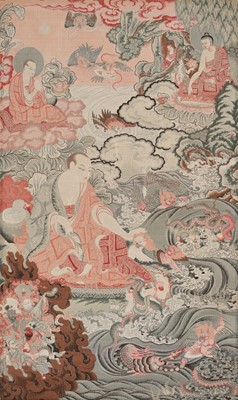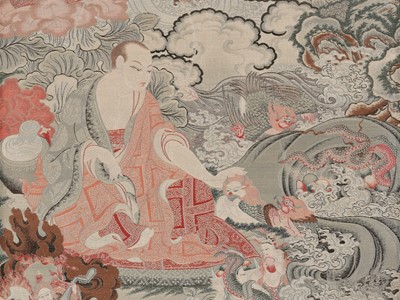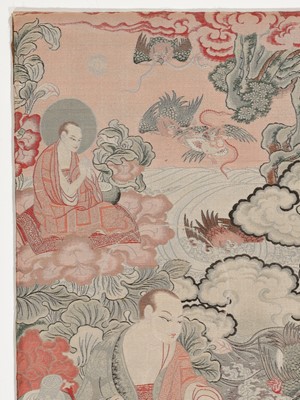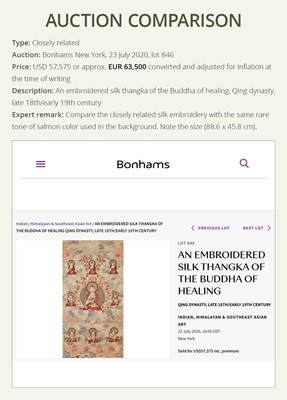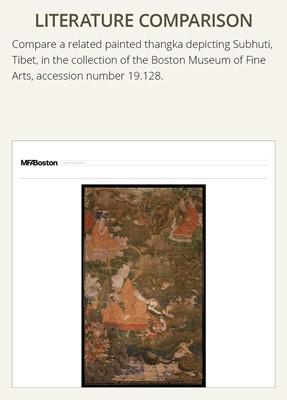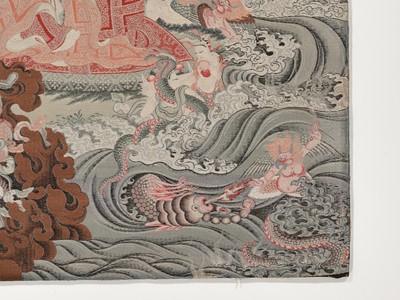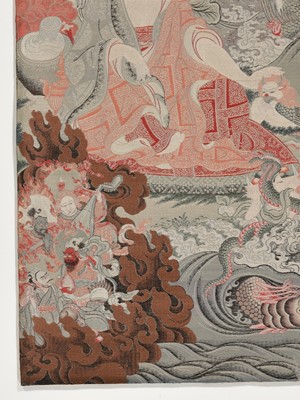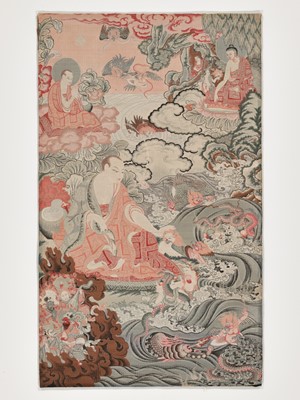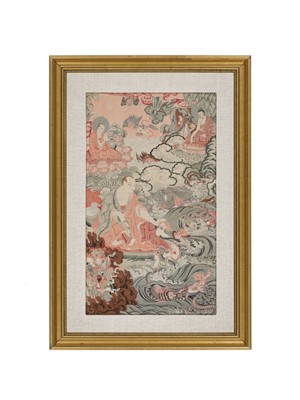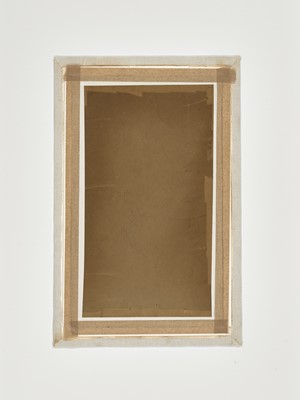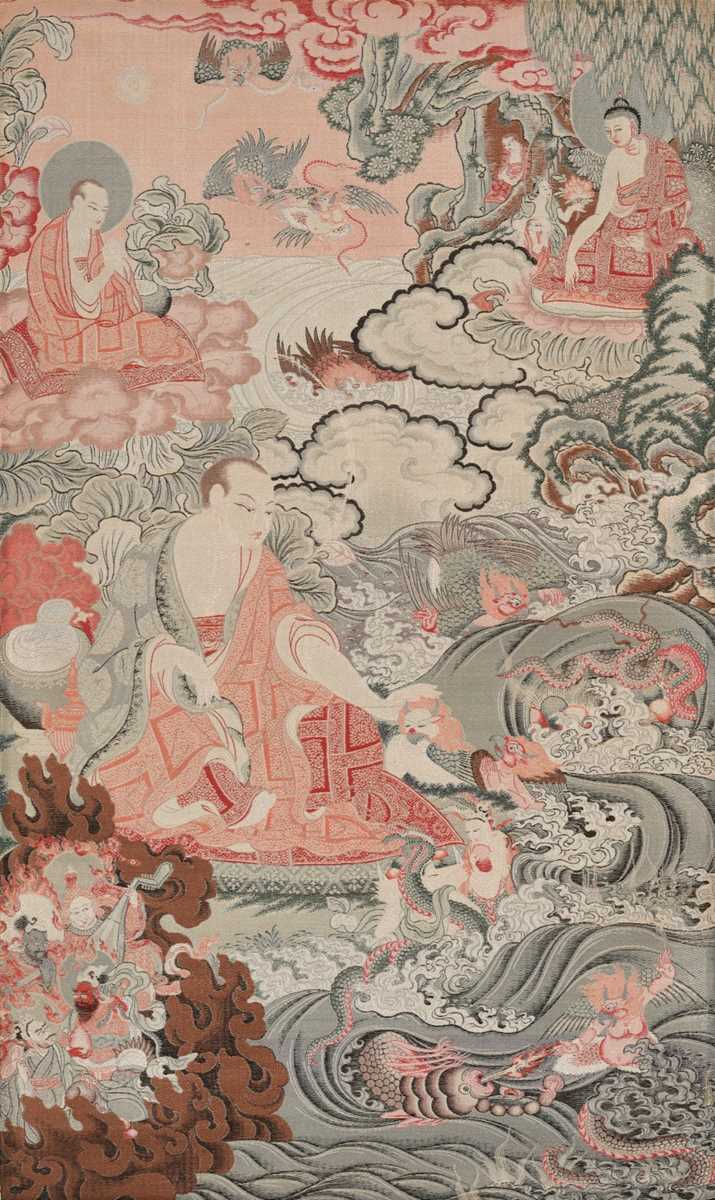9th Mar, 2023 13:00
TWO-DAY AUCTION - Fine Chinese Art / 中國藝術集珍 / Buddhism & Hinduism
192
AN EMBROIDERED SILK THANGKA OF SUBHUTI PREACHING TO NAGAS AND GARUDAS, QING DYNASTY
清代絲質刺繡須菩提修法唐卡
Sold for €2,600
including Buyer's Premium
China, late 18th to early 19th century, possibly Imperial workshops. Finely woven with the protector of Nagas, portrayed seated in lalitasana on a cushion next to a river with crashing waves, dressed in loose monk robes open at the chest, his left hand reaching out to gently caress a Garuda, accompanied by a monastic figure and Buddha in the earth-touching gesture with attendants in the upper register, protective deities, including Dhritarashtra in the lower left corner, framed by turbulent clouds, and various mythical beasts including Garudas, Nagas, and fish, in a landscape with lush trees, flowers and rocks, all beneath stylized clouds.
Provenance: From an old private collection in New York City, USA.
Condition: Very good condition with minor wear, little staining, and few loose threads. The frame with old wear, and small nicks.
Dimensions: Size incl. frame 87.3 x 59.8 cm, image size 66 x 38.7 cm
Matted and framed behind glass. (2)
Expert’s note: Silk textiles of high quality are among the most revered articles in Buddhist worship in China and Tibet. Similar to sculptures and paintings, the finest textile Buddha images were commissioned to accrue religious merit. During the early Ming dynasty, magnificent silk thangkas were produced by the Chinese Imperial workshops as gifts to Tibetan monasteries. The tradition of weaving and embroidering sacred images and presenting them as lavish gifts to Tibetan monks of the highest ranks not only continued throughout the Qing dynasty, but rather became a common governmental practice.
Subhuti became a monk after hearing the Buddha teach at the dedication ceremony of the Jetavana Monastery. After ordination, he went into the forest and became an arahant while meditating on loving-kindness. It is said that due to his mastery of loving-kindness meditation, any gift offered to him bore the greatest merit for the donor, thus earning him the title of foremost in being ‘worthy of gifts’. Subhuti is a major figure in Mahayana Buddhism and is one of the central figures in the Prajnaparamita sutra.
Literature comparison:
Compare a related painted thangka depicting Subhuti, Tibet, in the collection of the Boston Museum of Fine Arts, accession number 19.128.
Auction result comparison:
Type: Closely related
Auction: Bonhams New York, 23 July 2020, lot 846
Price: USD 57,575 or approx. EUR 63,500 converted and adjusted for inflation at the time of writing
Description: An embroidered silk thangka of the Buddha of healing, Qing dynasty, late 18th/early 19th century
Expert remark: Compare the closely related silk embroidery with the same rare tone of salmon color used in the background. Note the size (88.6 x 45.8 cm).
清代絲質刺繡須菩提修法唐卡
中國,十八世紀末至十九世紀初,或爲御製。精美刺繡,畫面正中為須菩提,正坐在湍急的洪水岸邊修法,左手伸出輕輕撫摸空中出現的羽翼豐滿的大鵬鳥;大鵬鳥俯衝而下降服毒龍。右上方繪釋迦牟尼為修行者傳法,左下角繪有四大天王。整幅唐卡繪畫內容豐富,形像生動,色彩艷麗。
來源:美國紐約私人舊藏。
品相:狀況極好,有輕微磨損、少量污漬和少量鬆線。邊框有磨損和小刻痕。
尺寸:總 87.3 x 59.8 厘米,畫面66 x 38.7 厘米
玻璃裝框。 (2)
專家注釋:高品質的絲綢紡織品是中國和西藏佛教文化中最受推崇的物品之一。與雕塑和繪畫相似,最好的佛像刺繡總是用來襯托宗教文化價值。明朝初期,中國皇家唐卡作坊製作了華麗的絲質唐卡,作為禮物送給西藏寺院。編織和刺繡聖像被作為貴重禮物贈予最高級別的西藏僧侶的傳統延續了整個清朝。
須菩提又稱須扶提,意為“善現”,為佛陀十大弟子之一,獲羅漢果位,以善解空理著稱,大乘空宗的著名經典《金剛般若波羅密多經》便是佛陀因須菩提之問而闡述的,須菩提也因而享有“解空第一”的稱譽。
文獻比較:
比較相近西藏的彩繪須菩提唐卡,收藏於波士頓美術館,館藏編號19.128。
拍賣結果比較:
形制:非常相近
拍賣:紐約邦瀚斯,2020年7月23日,lot 846
價格:USD 57,575(相當於今日EUR 63,500)
描述:清十八世紀末/十九世紀初 絲質刺繡藥師佛唐卡
專家評論:比較非常相近的絲質 刺繡,以及鮭魚色地。請注意尺寸 (88.6 x 45.8 厘米)。
China, late 18th to early 19th century, possibly Imperial workshops. Finely woven with the protector of Nagas, portrayed seated in lalitasana on a cushion next to a river with crashing waves, dressed in loose monk robes open at the chest, his left hand reaching out to gently caress a Garuda, accompanied by a monastic figure and Buddha in the earth-touching gesture with attendants in the upper register, protective deities, including Dhritarashtra in the lower left corner, framed by turbulent clouds, and various mythical beasts including Garudas, Nagas, and fish, in a landscape with lush trees, flowers and rocks, all beneath stylized clouds.
Provenance: From an old private collection in New York City, USA.
Condition: Very good condition with minor wear, little staining, and few loose threads. The frame with old wear, and small nicks.
Dimensions: Size incl. frame 87.3 x 59.8 cm, image size 66 x 38.7 cm
Matted and framed behind glass. (2)
Expert’s note: Silk textiles of high quality are among the most revered articles in Buddhist worship in China and Tibet. Similar to sculptures and paintings, the finest textile Buddha images were commissioned to accrue religious merit. During the early Ming dynasty, magnificent silk thangkas were produced by the Chinese Imperial workshops as gifts to Tibetan monasteries. The tradition of weaving and embroidering sacred images and presenting them as lavish gifts to Tibetan monks of the highest ranks not only continued throughout the Qing dynasty, but rather became a common governmental practice.
Subhuti became a monk after hearing the Buddha teach at the dedication ceremony of the Jetavana Monastery. After ordination, he went into the forest and became an arahant while meditating on loving-kindness. It is said that due to his mastery of loving-kindness meditation, any gift offered to him bore the greatest merit for the donor, thus earning him the title of foremost in being ‘worthy of gifts’. Subhuti is a major figure in Mahayana Buddhism and is one of the central figures in the Prajnaparamita sutra.
Literature comparison:
Compare a related painted thangka depicting Subhuti, Tibet, in the collection of the Boston Museum of Fine Arts, accession number 19.128.
Auction result comparison:
Type: Closely related
Auction: Bonhams New York, 23 July 2020, lot 846
Price: USD 57,575 or approx. EUR 63,500 converted and adjusted for inflation at the time of writing
Description: An embroidered silk thangka of the Buddha of healing, Qing dynasty, late 18th/early 19th century
Expert remark: Compare the closely related silk embroidery with the same rare tone of salmon color used in the background. Note the size (88.6 x 45.8 cm).
清代絲質刺繡須菩提修法唐卡
中國,十八世紀末至十九世紀初,或爲御製。精美刺繡,畫面正中為須菩提,正坐在湍急的洪水岸邊修法,左手伸出輕輕撫摸空中出現的羽翼豐滿的大鵬鳥;大鵬鳥俯衝而下降服毒龍。右上方繪釋迦牟尼為修行者傳法,左下角繪有四大天王。整幅唐卡繪畫內容豐富,形像生動,色彩艷麗。
來源:美國紐約私人舊藏。
品相:狀況極好,有輕微磨損、少量污漬和少量鬆線。邊框有磨損和小刻痕。
尺寸:總 87.3 x 59.8 厘米,畫面66 x 38.7 厘米
玻璃裝框。 (2)
專家注釋:高品質的絲綢紡織品是中國和西藏佛教文化中最受推崇的物品之一。與雕塑和繪畫相似,最好的佛像刺繡總是用來襯托宗教文化價值。明朝初期,中國皇家唐卡作坊製作了華麗的絲質唐卡,作為禮物送給西藏寺院。編織和刺繡聖像被作為貴重禮物贈予最高級別的西藏僧侶的傳統延續了整個清朝。
須菩提又稱須扶提,意為“善現”,為佛陀十大弟子之一,獲羅漢果位,以善解空理著稱,大乘空宗的著名經典《金剛般若波羅密多經》便是佛陀因須菩提之問而闡述的,須菩提也因而享有“解空第一”的稱譽。
文獻比較:
比較相近西藏的彩繪須菩提唐卡,收藏於波士頓美術館,館藏編號19.128。
拍賣結果比較:
形制:非常相近
拍賣:紐約邦瀚斯,2020年7月23日,lot 846
價格:USD 57,575(相當於今日EUR 63,500)
描述:清十八世紀末/十九世紀初 絲質刺繡藥師佛唐卡
專家評論:比較非常相近的絲質 刺繡,以及鮭魚色地。請注意尺寸 (88.6 x 45.8 厘米)。
Zacke Live Online Bidding
Our online bidding platform makes it easier than ever to bid in our auctions! When you bid through our website, you can take advantage of our premium buyer's terms without incurring any additional online bidding surcharges.
To bid live online, you'll need to create an online account. Once your account is created and your identity is verified, you can register to bid in an auction up to 12 hours before the auction begins.
Intended Spend and Bid Limits
When you register to bid in an online auction, you will need to share your intended maximum spending budget for the auction. We will then review your intended spend and set a bid limit for you. Once you have pre-registered for a live online auction, you can see your intended spend and bid limit by going to 'Account Settings' and clicking on 'Live Bidding Registrations'.
Your bid limit will be the maximum amount you can bid during the auction. Your bid limit is for the hammer price and is not affected by the buyer’s premium and VAT. For example, if you have a bid limit of €1,000 and place two winning bids for €300 and €200, then you will only be able to bid €500 for the rest of the auction. If you try to place a bid that is higher than €500, you will not be able to do so.
Online Absentee and Telephone Bids
You can now leave absentee and telephone bids on our website!
Absentee Bidding
Once you've created an account and your identity is verified, you can leave your absentee bid directly on the lot page. We will contact you when your bids have been confirmed.
Telephone Bidding
Once you've created an account and your identity is verified, you can leave telephone bids online. We will contact you when your bids have been confirmed.
Classic Absentee and Telephone Bidding Form
You can still submit absentee and telephone bids by email or fax if you prefer. Simply fill out the Absentee Bidding/Telephone bidding form and return it to us by email at office@zacke.at or by fax at +43 (1) 532 04 52 20. You can download the PDF from our Upcoming Auctions page.
How-To Guides
How to Create Your Personal Zacke Account
How to Register to Bid on Zacke Live
How to Leave Absentee Bids Online
How to Leave Telephone Bids Online
中文版本的操作指南
创建新账号
注册Zacke Live在线直播竞拍(免平台费)
缺席投标和电话投标
Third-Party Bidding
We partner with best-in-class third-party partners to make it easy for you to bid online in the channel of your choice. Please note that if you bid with one of our third-party online partners, then there will be a live bidding surcharge on top of your final purchase price. You can find all of our fees here. Here's a full list of our third-party partners:
- 51 Bid Live
- EpaiLive
- ArtFoxLive
- Invaluable
- LiveAuctioneers
- the-saleroom
- lot-tissimo
- Drouot
Please note that we place different auctions on different platforms. For example, in general, we only place Chinese art auctions on 51 Bid Live.
Bidding in Person
You must register to bid in person and will be assigned a paddle at the auction. Please contact us at office@zacke.at or +43 (1) 532 04 52 for the latest local health and safety guidelines.
